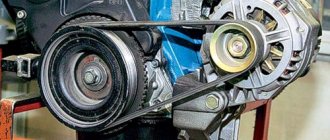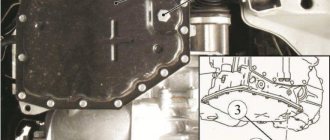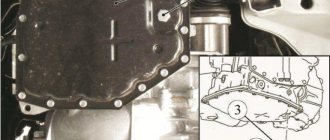LADA Priora car contacted a service station was extraneous noise when the steering wheel moved. During diagnostics, a humming sound from the power steering pump was detected. Apparently its work has come to an end, or the power steering has been changed very rarely (the recommended frequency is 50-60 thousand kilometers ). You can try to simply change the fluid to the original one or try to temporarily restore the pump, but it is better to immediately replace the power steering on the Priora and not waste time. In addition, it is cheaper than buying fluid and a repair kit twice.
Replacing fluid in the power steering on a Priora
Welcome!
Oil in the hydraulic power steering - thanks to it, the ease of rotation of the steering wheel is ensured (I mean thanks to the oil), but thanks to the hydraulic power steering itself, of course, it is easy to turn the steering wheel, but if there is no oil in it, then it will not work either, Therefore, you need to constantly monitor the oil level and be sure to change the oil itself from time to time, because it, like any other oil, does not last forever. Note! In order to change the oil in the power steering, you will need to stock up on a set of tools, namely: We recommend that if you have two jacks, they are needed to lift both front wheels up and thereby the steering wheel will turn much easier, and the steering wheel you will have to turn for a very long time with the power steering not working, since when changing the oil it will not work for you, and you will also need to stock up on a medical syringe and a small long hose that you will put on this syringe, and you will also need a container into which you will drain used oil and, accordingly, a few unnecessary rags in order to cover with them all the belts on which oil could presumably get on when draining the used fluid from the power steering reservoir!
- Replacing power steering fluid
- Additional video clip
Where is the power steering reservoir located? In general, when changing the oil, you will use only this tank, because it contains the oil itself and you won’t even need to get to the other parts of the power steering, but the tank is located in the engine compartment of the car, so you will need to first open the hood and then find it (It is indicated in the photo below by an arrow).
When should you change the power steering oil? It is recommended to change the oil once every 2, or at least once every 3 years, during which time the oil already loses all its additives and in connection with this, extraneous noise may appear when the power steering is operating, and vibrations emitted by the power steering may also appear, and in general, you can’t drive on old oil (We’ll call it used oil) for a long time, because it loses its additives, and if it loses its additives, then its purpose is to protect the bellows from breakdowns and because of this the mechanism will fail much faster.
Note! Don’t always look at how long the car has run on new oil, or how many years have passed since the last fill, it’s better to check everything yourself, regardless of the numbers, to do this, unscrew the top cap of the tank (It is also indicated by the arrow), and after it you will be turned out, look at the oil itself, if it is darkened and there is also a burning smell to all this, then this oil must be changed to a new one without delay!
How to change the oil in the power steering on a VAZ 2170-VAZ 2172?
Note! The work of changing the oil is best done with an assistant because in this work he will really come in handy, since one of you will need to monitor the oil level, and the other will need to turn the steering wheel, and as they say, it’s more fun together!
Draining: 1) At the beginning of the operation, at your discretion, either lift both front wheels using two jacks, or skip this point and move on to the next one, just when you drive the used oil out of the system, you will have to sit in the car and turn steering wheel to the left (all the way), right (all the way), etc., it’s just that it will be difficult to do this with the wheels not hanging out.
Note! If you find yourself on the ground or loose soil (in general, on a surface that sag), then we recommend that you place bricks under the rear wheels so that the car does not fall off the jacks, and before placing the car on them, place a hard plank under both jacks!
2) Then unscrew the cap of the power steering reservoir (This cap is also indicated by an arrow in the photo above), and when it is open, pick up a syringe and push it deep into the reservoir, and then collect all the waste fluid from the reservoir and pour it into a previously prepared container for this.
Note! Do this operation again and again until all the oil is sucked out of the tank; by the way, for convenience, if you want, you can also put a small but sufficiently long hose on the syringe, as shown in the photo below:
When you work with oil, that is, suck it out of the tank or fill it with new one, in any case, cover all the belts under which you will carry oil with rags or something else, because rubber does not like oil!
3) Now ask your assistant to get into the car, but only carefully if your car is on jacks and after he sits down, let him turn the steering wheel from lock to lock, and while he turns it, you at this time Keep an eye on the tank; used oil should appear in it; use a syringe to take this oil and pour it again into the prepared container.
4) Next, you will need to loosen the clamp that secures the oil return hose to the power steering reservoir (see photo 1), so when the clamp is loosened, disconnect this reservoir hose and lower it into a container for draining used oil (see photo 2 ).
Note! And when it is lowered into the container, tell your assistant to turn the steering wheel again in the same way as he did before, and after the oil has been completely drained from the hose, connect it to its place and re-tighten the clamp and check to hold firmly!
What else, if you have liquid left in the tank itself (for example, you haven’t drained it completely, although you don’t need to do that), then be sure to close the hole to which the hose fits with your hand, so that oil doesn’t leak from there onto the engine and dirty it !
Filling: 1) First, take a can purchased from a car store with new oil and then start pouring oil into the tank, be sure to pour the oil to the very top, and after it is poured, let your assistant turn the steering wheel again in the same way from edge to edge , and you will continue to pour oil into the tank because when the assistant turns the steering wheel, as it rotates, it will leave the tank.
2) After the oil has stopped decreasing, let your assistant stop turning the steering wheel and start the car for literally 10 seconds, the oil after starting it will also begin to decrease, but you constantly monitor its level and add oil as it decreases so that it reaches the very top.
3) When the car has been running for 10 seconds, turn it off, and then ask an assistant to turn the steering wheel in the same way, while you monitor the oil level in the power steering reservoir.
Do-it-yourself power steering oil change for Lada Priora
Good day everyone! This article will tell you how to independently change the power steering oil of a Lada Priora. The procedure is simple and under normal conditions will take no more than one hour. So, first, let's decide what tools and materials we will need. First, we need the power steering fluid itself. 1 liter will be enough for replacement. Recommended liquid:
Pentosin CHF 11S. Article number for searching in online stores: 4 008849 503016
In addition, other fluids can be used in Priora power steering. For example: FEBI 46161 Vaico V60-0018 SWAG 99 90 6162 You can also use any liquid with Dexron II or III standard. These are automatic transmission fluids, but they can also be used in power steering Lada Priora. We will also need: - Jack - 2 pcs. — Plastic bottle 0.5l, 1.5l — 1 pc. — Syringe and thin hose — 1 pc. - Screwdriver.
Instructions for changing Priora power steering oil
It is recommended to change the Priora power steering oil at least once every 60,000 km. However, if the oil in the power steering reservoir has darkened, you should not wait for the required interval. It is necessary to immediately replace the oil with a new one.
1. The first step is to raise the front of the car. This is necessary in order to make it easier to turn the steering wheel. Two regular jacks will do for this.
2. Using a regular medical syringe, pump out the fluid from the power steering reservoir into any container.
3. When the liquid is drained, remove the return hose from the tank and insert it into a plastic bottle. At this stage of changing the Priora power steering oil, it is better to get an assistant who will rotate the steering wheel all the way in both directions. When the steering wheel rotates, fluid is squeezed out of the system. As practice shows, to completely pump out fluid from the system, 8-10 full turns of the steering wheel all the way are sufficient.
4. Reinstall the return hose and fill the reservoir with new power steering fluid. After the tank is full, the assistant begins to turn the steering wheel again.
At this point, the power steering fluid will begin to gradually drain through the system. When the level decreases, it is necessary to gradually add new oil to the tank. The work is carried out until the liquid in the tank stops leaving. Then we set the required level in the tank by adding or pumping out oil. We wrap the cover and lower the car from the jacks.
That's all! The Priora power steering oil change is now complete. Do you agree that everything is not so complicated? And such a simple procedure will extend the life of the power steering pump significantly. Don’t skimp on consumables, see you next time!
What kind of oil to pour into the power steering
Among domestic car enthusiasts, the question of what kind of oil to pour into the power steering is solved extremely simply: the lubricant is selected by color. In fact, the differences between power steering oils lie not in its shade, but in its composition, viscosity, type of base, impurities and other equally important nuances that can have a beneficial or negative effect on the power steering system.
What oil is best to fill in the power steering?
Currently, all power steering oils can be divided into two types: mineral and synthetic. There are active discussions among domestic motorists about which oil is better, while the car manufacturers themselves recommend using mineral lubricants.
This is explained by the fact that synthetics have a detrimental effect on the rubber parts of the power steering due to the chemical aggressiveness of the substances that make up the oils. The use of synthetics is relevant for rubber parts made of a special composition; recommendations for the use of such oils are indicated by the car manufacturer.
Based on color and shade, power steering oils can be divided into three types:
- Red (natural and synthetic lubricants of the Dexron family, mixing is prohibited!);
- Yellow (natural oils used in power steering systems of most modern cars);
- Green (natural and synthetic oils used for power steering systems of cars manufactured in France are prohibited from mixing!).
To avoid negative consequences, accelerated wear and expensive repairs, it is important to remember that mixing mineral and synthetic oils is strictly prohibited. Mixing red and yellow lubricants is allowed, while green power steering oils are prohibited from mixing with any others.
What kind of oil should I put in Toyota power steering?
During the operation of new Japanese cars, sooner or later, every driver is faced with the problem of changing power steering fluid and does not know what kind of oil to pour into the Toyota power steering, entrusting the oil change to professionals.
At the same time, few people know that the type of oil poured into the power steering system of cars of the Japanese Toyota family is indicated on the cap of the power steering reservoir. In most cases, Japanese car manufacturers recommend using standard DEXRON III fluid.
Toyota car owners note that DEXRON III is the best option for models produced since the early 2000s. Currently, Mobil, Texaco, Castrol, ESSO and Shell produce DEXRON III oils for Japanese cars, so you can find the liquid without any problems.
What kind of oil should I put into the Mercedes power steering?
To figure out what kind of oil to pour into the Mercedes power steering, you need to familiarize yourself with the factory specifications of the car. Often, the Germans recommend using mineral fluids, since natural rubber is used in the production of rubber parts for the power steering system.
Interesting: For both Japanese and German cars, the best option is DEXRON III fluid. At the same time, Mercedes owners are advised not to spare money and fill in a liquid that has a classifier that corresponds to the official parameters specified by the manufacturer. The original power steering system oil in Mercedes cars has a characteristic green color and is suitable for all cars produced since the early 90s.
When choosing power steering oil for German cars, it is recommended to consult with professionals, or even take the car for service.
What kind of oil should I fill in my Opel power steering?
Often, without understanding what kind of oil to fill in the Opel power steering, most owners of cars of this brand are guided by general advice, as a result of which the system wears out several times faster. Like Mercedes, power steering oils for Opel cars have their own classification, which can be found in the technical documentation of the car. It is worth noting that the modern market offers a lot of analogues, represented by oils that are not inferior in quality to the original.
What kind of oil to pour into the power steering of a Chevrolet Lacetti
Lacetti is a universal car, so the answer to the question of what kind of oil to pour into the power steering of a Chevrolet Lacetti is yellow DEXRON III fluid, a universal solution for all types of power steering systems. By the way, the manufacturer indicates DEXRON as one of the most optimal, inexpensive and acceptable replacement options.
What kind of oil is poured into the power steering of the Hyundai Solaris?
There are many options for what kind of oil is poured into the power steering of a Hyundai Solaris, but the only correct one is the factory fluid PSF-4, Hyundai Genuine Part No.: 03100-00130, suitable for all cars of the Hyundai family. As an alternative, you can use PSF-4 oils produced by other companies, but at the same time it is recommended to clarify its classifier by checking it with the data posted on the official Hyundai website.
What kind of oil should I pour into the Priora power steering?
In search of an answer to the question of what kind of oil to fill in the Priora power steering, it is recommended that you familiarize yourself with the factory parameters of modern LADA cars. In the factory version, the power steering system of domestic cars uses synthetic oils Pentosin Hydraulik Fluid CHF 11S-TL (VW52137). As an alternative, you can use universal oils for power steering, while “factory” fluid labeled VW52137 can be purchased exclusively from authorized dealers. It is worth noting that the manufacturer recommends filling exclusively with VW52137, thereby protecting car parts from premature wear.
What kind of oil to pour into the Priora's power steering
Changing the oil in the power steering of Lada Priora
Power steering (power steering) is installed in almost every modern car. what oil to put in a cr-v for the winter what oil to put in a cr-v for the winter 2008 Liqui Molly, Honda. The purpose of the power steering is to facilitate steering turns by introducing oil injection under high pressure. Now I will tell you how to change the oil in the power steering of a Lada Priora with your own hands.
Note that according to generally accepted rules, power steering oil is changed at least once every 4-5 years or every 80 thousand. km. mileage
To change the oil we need: 1. Two jacks.2. Syringe with hose.3. What kind of oil is needed in an automatic transmission? can be poured into a Renault box. A rag or cellophane to cover the straps.
4. Anyway, what kind of oil should I pour into the turboSuba? In the automatic transmission Subaru 5ATF Outback 2007MY Europe-Restyle 2.54AT. Container for old oil.
Do-it-yourself power steering oil change:
1. First of all, you need to jack up the front end, this will simplify the task when you need to expel old oil from the system. To do this, use two jacks.
2. To pump out the oil from the tank, take a syringe and put a hose of a suitable diameter on it (suitable from a washer or medical “system”).
3. What kind of engine oil and how much to pour into the engine. Then cover the belts with something (cellophane, rag...) so that oil doesn’t get on them, rubber doesn’t like that.
Selection of power steering oil
Here we will tell you how not to kill your power steering and how to choose the right power steering oil for your car.
REPLACING POWER POWER FLUID VAZ-2110, 2111, 2112 PRIORA,KALINA,GRANT
Complete replacement of power steering fluid VAZ FAMILY.
4. Start pumping the oil into the prepared container.
5. When the oil is pumped out, ask an assistant to turn the steering wheel as far as possible to the left/right. With these movements, oil will appear in the tank again, your task is to immediately pump it out.
6. What kind of oil should I put in a 2.2 liter Mercedes diesel? After this, disconnect the “return” hose and lower its end into some bottle, and turn the steering wheel again, the system will again expel the old oil.
7. Hydraulic oil in the power steering from the factory and or green? Priora 2012 onwards. After the oil has been completely drained, reconnect the hose.
8. Fill the power steering system with new oil, up to the top.
9. What kind of oil to fill into the engine of the Daewoo Nexia: 8 i. When the oil is poured, ask a friend to turn the steering wheel, while you continue to add oil as it decreases into the system.
10. After the oil has stopped decreasing, start the engine for 10-15 seconds. During operation, the oil will also decrease - add again.
11. Turn off the engine, turn the steering wheel again 5-7 times in each direction until it stops, make sure that there are no air bubbles in the tank.
12. What kind of oil to pour into the VAZ 2110 engine. Add oil to the level if necessary.
13. Check the operation by starting the engine and trying to turn the steering wheel. There should be no noise or difficulty during rotation, the steering wheel should be soft and rotate without problems.
If you have already decided to change the power steering oil yourself, don’t forget about the engine.
Welcome! Oil in the hydraulic power steering - thanks to it, the ease of rotation of the steering wheel is ensured (I mean thanks to the oil), but thanks to the hydraulic power steering itself, of course, it is easy to turn the steering wheel, but if there is no oil in it, then it will not work either, Therefore, you need to constantly monitor the oil level and be sure to change the oil itself from time to time, because it, like any other oil, does not last forever.
Note! In order to change the oil in the power steering, you will need to stock up on a set of tools, namely: We recommend that if you have two jacks, they are needed to lift both front wheels up and thereby the steering wheel will turn much easier, and the steering wheel you will have to turn for a very long time with the power steering not working, since when changing the oil it will not work for you, and you will also need to stock up on a medical syringe and a small long hose that you will put on this syringe, and you will also need a container into which you will drain used oil and, accordingly, a few unnecessary rags, in order to cover with them all the belts on which oil could presumably get on when draining the used fluid from the power steering reservoir!
Summary:
Where is the power steering reservoir located? In general, when changing the oil, you will use only this tank, because it contains the oil itself and you won’t even need to get to the other parts of the power steering, but the tank is located in the engine compartment of the car, so you will need to first open the hood and then find it (It is indicated in the photo below by an arrow).
When should you change the power steering oil? It is recommended to change the oil once every 2, or at least once every 3 years, during which time the oil already loses all its additives and in connection with this, extraneous noise may appear when the power steering is operating, and vibrations emitted by the power steering may also appear, and in general, you can’t drive on old oil (We’ll call it used oil) for a long time, because it loses its additives, and if it loses its additives, then its purpose is to protect the bellows from breakdowns and because of this the mechanism will fail much faster.
Note! Don’t always look at how long the car has run on new oil, or how many years have passed since the last fill, it’s better to check everything yourself, regardless of the numbers, to do this, unscrew the top cap of the tank (It is also indicated by the arrow), and after it you will be turned out, look at the oil itself, if it is darkened and there is also a burning smell to all this, then this oil must be changed to a new one without delay!
Operating procedure
Before starting work, you need to prepare a container where the oil will drain. Castrol is no exception.
- Jack up the front wheels. Two tools should be enough for this. The procedure will be especially useful when you have to drain the old composition.
- A bulb or syringe will help rid the structure of old liquid. The oil tank becomes one of the most important parts.
- It is necessary to cover the belts with something. This will protect them from the oil, otherwise it will be difficult to get rid of the marks later.
- You need to call an assistant so that he can twist the steering wheel as much as possible, either to the right or to the left. Oil will appear in the tank again, which must be pumped out immediately.
- The return hose is turned off. It doesn't matter if you use Hadot oil, Eneos oil or something else.
- The hose is lowered into the bottle, after which the old excess liquid is drained again.
- You can connect the hose back when everything is completely drained.
- A new composition is poured in until the Lada Priora part is completely filled. The frequency of replacement has already been described previously.
- Again you need to ask someone to turn the steering wheel. Oil is added to the system as it drains.
- The specification says that you need to start the engine for 10-15 seconds after the work has been completed. The liquid will begin to decrease again. And again topping up is required.
- It remains to make sure that when turning the steering wheel no air bubbles appear in the tank. Power steering always requires such checks.
- If necessary, add oil to the appropriate level.
After all the steps have been completed, you need to start the engine and turn the steering wheel to the side. Factory oil should not cause any problems. The presence of hum is also unacceptable. The rotation should be very smooth, without any problems.
How to change the oil in the power steering on a VAZ 2170-VAZ 2172?
Note! The work of changing the oil is best done with an assistant because in this work he will really come in handy, since one of you will need to monitor the oil level, and the other will need to turn the steering wheel, and as they say, it’s more fun together!
Draining: 1) At the beginning of the operation, at your discretion, either lift both front wheels using two jacks, or skip this point and move on to the next one, just when you drive the used oil out of the system, you will have to sit in the car and turn steering wheel to the left (all the way), right (all the way), etc., it’s just that it will be difficult to do this with the wheels not hanging out.
Note! If you find yourself on the ground or loose soil (in general, on a surface that sag), then we recommend that you place bricks under the rear wheels so that the car does not fall off the jacks, and before placing the car on them, place a hard plank under both jacks!
2) Then unscrew the cap of the power steering reservoir (This cap is also indicated by an arrow in the photo above), and when it is open, pick up a syringe and push it deep into the reservoir, and then collect all the waste fluid from the reservoir and pour it into a previously prepared container for this.
Note! Do this operation again and again until all the oil is sucked out of the tank; by the way, for convenience, if you want, you can also put a small but sufficiently long hose on the syringe, as shown in the photo below:
When you work with oil, that is, suck it out of the tank or fill it with new one, in any case, cover all the belts under which you will carry oil with rags or something else, because rubber does not like oil!
3) Now ask your assistant to get into the car, but only carefully if your car is on jacks and after he sits down, let him turn the steering wheel from lock to lock, and while he turns it, you at this time Keep an eye on the tank; used oil should appear in it; use a syringe to take this oil and pour it again into the prepared container.
Bleeding using a special kit
This method is suitable for bleeding power steering of later car models, but it can be used on any vehicle. The method involves the use of a vacuum pump, with which you can pull out an air lock of any complexity without damaging the seals. In addition, using a special pumping kit significantly speeds up the process.
To carry out the work, you will need to take a vacuum pump and a kit for purging the power steering system. The execution procedure looks like this:
- The car is installed on a flat surface.
- We wait for the engine to cool completely and open the hood.
- Remove the cover and install the adapter for the vacuum pump in its place.
- We connect the device to the air vent.
- Start the engine.
- Using a pump, we create a vacuum of 20 inches (508 mm) of mercury.
- We wait 5 minutes and check whether the discharge indicator has dropped. This is necessary to ensure the integrity of the system. If the arrow gradually moves, this is not a big deal, but if the readings change quickly, you can judge that the system is depressurizing. This means that air can be sucked in through the hole while driving.
- If your car has power brakes, be sure to press this pedal several times as well.
- Smoothly turn the steering wheel from side to side 10 times without pressing the stops.
- We align the wheels in the center and turn off the engine.
- Remove the pump and adapter to bleed the system.
If there are air bubbles on the surface, you need to wait about 5 minutes. During this time they should completely disappear. Now the working fluid level is checked, it should be at the MAX level. Top up if necessary.
After this, replace the cover with a vacuum pump again and repeat the procedure from the beginning. The complete absence of bubbles will signal completion. In this case, a cap is screwed onto the expansion tank, and the system is checked for leaks.
What oil is best to fill in the power steering?
Currently, all power steering oils can be divided into two types: mineral and synthetic. There are active discussions among domestic motorists about which oil is better, while the car manufacturers themselves recommend using mineral lubricants.
This is explained by the fact that synthetics have a detrimental effect on the rubber parts of the power steering due to the chemical aggressiveness of the substances that make up the oils. The use of synthetics is relevant for rubber parts made of a special composition; recommendations for the use of such oils are indicated by the car manufacturer.
Based on color and shade, power steering oils can be divided into three types:
- Red (natural and synthetic lubricants of the Dexron family, mixing is prohibited!);
- Yellow (natural oils used in power steering systems of most modern cars);
- Green (natural and synthetic oils used for power steering systems of cars manufactured in France are prohibited from mixing!).
To avoid negative consequences, accelerated wear and expensive repairs, it is important to remember that mixing mineral and synthetic oils is strictly prohibited. Mixing red and yellow lubricants is allowed, while green power steering oils are prohibited from mixing with any others.
Several recommendations for further use
The procedure for bleeding the power steering will help restore the controllability of your vehicle. But to maintain results for as long as possible, you must adhere to several rules:
- fill only with high-quality hydraulic fluid from trusted brands recommended by your car manufacturer;
- carry out timely replacement (every 60-120 thousand km) of hydraulic fluid in the power steering system;
- during pumping, strictly follow the sequence of actions;
- Monitor the condition and operation of the steering rack boot, promptly clean it from dust and other contaminants.
Bleeding the power steering is a very important procedure, which is necessary to maintain the vehicle and all its systems in normal operating condition. Neglecting it can lead to various control problems requiring expensive repairs and even an accident.
What kind of oil should I put in Toyota power steering?
During the operation of new Japanese cars, sooner or later, every driver is faced with the problem of changing power steering fluid and does not know what kind of oil to pour into the Toyota power steering, entrusting the oil change to professionals.
At the same time, few people know that the type of oil poured into the power steering system of cars of the Japanese Toyota family is indicated on the cap of the power steering reservoir. In most cases, Japanese car manufacturers recommend using standard DEXRON III fluid.
Toyota car owners note that DEXRON III is the best option for models produced since the early 2000s. Currently, Mobil, Texaco, Castrol, ESSO and Shell produce DEXRON III oils for Japanese cars, so you can find the liquid without any problems.
see also
Characteristics of Dextron 2 and 3 - what are the differences
- 35 1 23k
Power steering malfunctions
- 19 0 28k
What kind of oil to fill in power steering
- 156 0 207k
Power steering buzzes
- 351 7 316k
15 best power steering fluids
- 117 9 362k
Bleeding the power steering and its system is carried out when replacing the working fluid, airing, which may be the result of a malfunction or repair work. Air trapped inside not only reduces the efficiency of the power steering, but can also cause serious damage, in particular, failure of the power steering pump. Therefore, pumping the hydraulic booster must be carried out in strict accordance with existing technology.
What kind of oil should I put into the Mercedes power steering?
To figure out what kind of oil to pour into the Mercedes power steering, you need to familiarize yourself with the factory specifications of the car. Often, the Germans recommend using mineral fluids, since natural rubber is used in the production of rubber parts for the power steering system.
Interesting: For both Japanese and German cars, the best option is DEXRON III fluid. At the same time, Mercedes owners are advised not to spare money and fill in a liquid that has a classifier that corresponds to the official parameters specified by the manufacturer. The original power steering system oil in Mercedes cars has a characteristic green color and is suitable for all cars produced since the early 90s.
When choosing power steering oil for German cars, it is recommended to consult with professionals, or even take the car for service.
What kind of oil should I fill in my Opel power steering?
Often, without understanding what kind of oil to fill in the Opel power steering, most owners of cars of this brand are guided by general advice, as a result of which the system wears out several times faster. Like Mercedes, power steering oils for Opel cars have their own classification, which can be found in the technical documentation of the car. It is worth noting that the modern market offers a lot of analogues, represented by oils that are not inferior in quality to the original.
Interchangeability and classification of oils
Typically, oils are divided into several types depending on color. How often to change the oil has already been described. The classification by color is not entirely correct. And don’t think that you can mix different brands of oils, even if they have exactly the same color. The composition and viscosity can always be different.
Power steering oils vary and have different features depending on the color.
There are some features associated with the color of the oil that are worth considering in more detail.
- Green color. This family is mainly used in VAG, Citroen, and Peugeot cars. The main thing is to never mix mineral water with synthetics if they have this color. Automatic transmission oil is never suitable.
- Mercedes cars use a yellow grade of oil.
- Dexrons are red. Only for automatic transmissions.
What kind of oil should I pour into the Priora power steering?
In search of an answer to the question of what kind of oil to fill in the Priora power steering, it is recommended that you familiarize yourself with the factory parameters of modern LADA cars. In the factory version, the power steering system of domestic cars uses synthetic oils Pentosin Hydraulik Fluid CHF 11S-TL (VW52137). As an alternative, you can use universal oils for power steering, while “factory” fluid labeled VW52137 can be purchased exclusively from authorized dealers. It is worth noting that the manufacturer recommends filling exclusively with VW52137, thereby protecting car parts from premature wear.
Signs of malfunctions in the power steering system
There are several signs that the power steering system is airy, in which case it is necessary to bleed it. Among them:
- the appearance of strong noise in the area where the power steering or its pump is installed;
- increased pressure on the steering wheel , difficulty turning it;
- leakage of working fluid from the power steering system.
In addition, there are several other signs that indicate the system is becoming airy - the appearance of foam on the surface of the working fluid in the expansion tank, spontaneous turns of the steering wheel to one side. If you encounter at least one of the described symptoms, it means you need to bleed your power steering.











